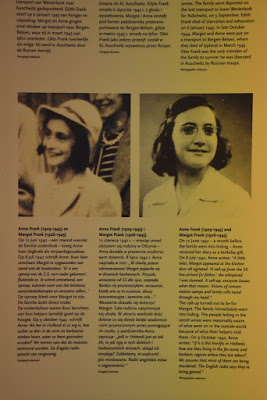 |
| Arbeit macht frei - Works gives you freedom |
This entrance has become worldwide known - it leads to the largest nazi German concentration camp and death camp - AUSCHWITZ.
In the years 1940-1945, the nazis deported at least 1,300,000 people to Auschwitz.
1,100,000 Jews
150,000 Poles
23,000 Roma (gypsies)
15,000 Soviet prisoners from the war
25,000 Prisoners from other ethnic groups
1,100,000 of these people died in Auschwitz. Approximately 90% of the victims were Jews. The SS murdered the majorityof them in the gas chambers.
Estimated number of Jews deported to Auschwitz:
430 000 from Hungary
300 000 from Poland
69 000 from France
60 000 from The Netherlands
55 000 from Greece
46 000 from Czech (Bohemia and Moravia)
27 000 from Slovakia
25 000 from Belgium
23 000 from Austria and Germany
10 000 from Yugoslavia
7 500 from Italy
690 from Norway
Plus approximately 34 000 Jewish individuals transferred from other concentration camps.
These numbers has terrible and painful history and we should never forget it.
Photo from the ghetto in Thessaloniki 1942-1943.
The camp orchestra had to assemble here to play marches while the prisoners filled past. This was to help prisoners keep in step and make it easier to count them as they went to and from work.
Blocks 1-10 were used as a camp for women prisoners in March 1942 until August 1942.It was seperated from the men´s camp by a high wall. About 17 000 women, Jewish and non-Jewish who had been deported there were housed here. During these months few thousand women were sent to the gas chambers or died as result of the conditions in the camp-starvation, epidemics and slave labour. Those who were still alive in August 1942 were transfered to the main new camp in Auschwitz-Birkenau.
After the war, these things were found between a wall. Someone must have hide them and have try to escape.
So so many photos from the prisoners who where held here.
Maria, arrived in the camp in the age of 16. Lived less than 4 months..
Maier, arrived in the camp in the age of 58, died just one day after..
Room conditions for prisoners.
The block elders room as well as by the members of SS. These prisoners supervised fellow prisoners.
This man needs no presentation.
Sanitary conditions.
The washroom were women stripped before execution. Then they were led in twos and shot at the "DEATH WALL".
Door leading out to the Death Wall
Death Wall
The Nazis deported about 232,000 children and young people to Auschwitz, including 216,000 Jewish children, 11,000 roma (gupsy) children, 3,000 Polish children and 1,000 Slavic children of other nationalities. The majority of the Jewish children perished in the gas chambers immediately after arrival. On January 27 January 1945 Red Army soldiers liberated about 650 children and young people of which 450 were under 15 years old.
The Nazis did not throw ANYTHING away. Even the hairs from the women were used in German textile industry and piles of hair was to see still here. Piles of shoes, piles of brushes, piles of hairs...
Wooden case with a set of number-stamps and metal needles for tatooing the prisoners.
SS-man showing the way to the "paradise" for the Jewish people, when they were asking where are they bringing them.
"The paradise" was gas chambers were Jews got gazed with these canisters containing Zyklon B.
In Auschwitz museum you can visit many buildings where are now documentation per country. You would really need few days to stay there if you like to visit them all. I visited The Dutch house in Auschwitz, since I am in close relation with Holland and visited also Anne Frank´s house in Amsterdam and read first time her diary when I was 15 years old.
Anne Frank was one of the 60,000 Dutch prisoners.
I was photographing these names on a big "panel" on the wall...
This photo is showing the actual size of one panel, from the floor to the roof, full of names of the victims.
Not "just" one panel, many panels filling the room with names.
After the war - Free Holland welcomes the soldiers of allies - welcome to the free Holland!
Birkenau railway where the Jews were brought..
Famous entrance to Auschwitz-Birkenau death camp.
Train to death
Monument in Birkenau camp
This barrack (the Death Barrack) was used for the special isolation of those women prisoners of the concentration camp who were selected by the SS as unfit for further work to be sent to be murdered in the gas chambers. Here they had to await their deaths, without food or water and often for several days. Many died in the barrack before they were summoned. When the barrack was full, additional prisoners who had been selected for death were kept outside in a locked yard.
Death Barrack from inside.
A drawing showing when the prisoners walks trough the Arbeit macht frei - Works gives you freedom gate...
The tour lasted five hours with a guide and the camps are open until 8 pm so I went back there on my own to see still more things in private. As a I said earlier in this place are plenty of things to see so you can also stay there few days to see more. Entrance fee was 45 zt (10 e) including the guided tour in these two camps, Auschwitz and Birkenau. After 3 pm, entrance is free. In Auschwitz you can park in the museum parking (photo above) and it costed 30 zt per day (I stayed 2 nights so 60 zt, 13.5 e).
GPS coordinates for this parking are N 50°01'43" E 19°12´04".

































































Aivan järkyttävää!Ihminen on luomakunnan pahin.Hyvä ja vaikuttava teksti.
ReplyDelete